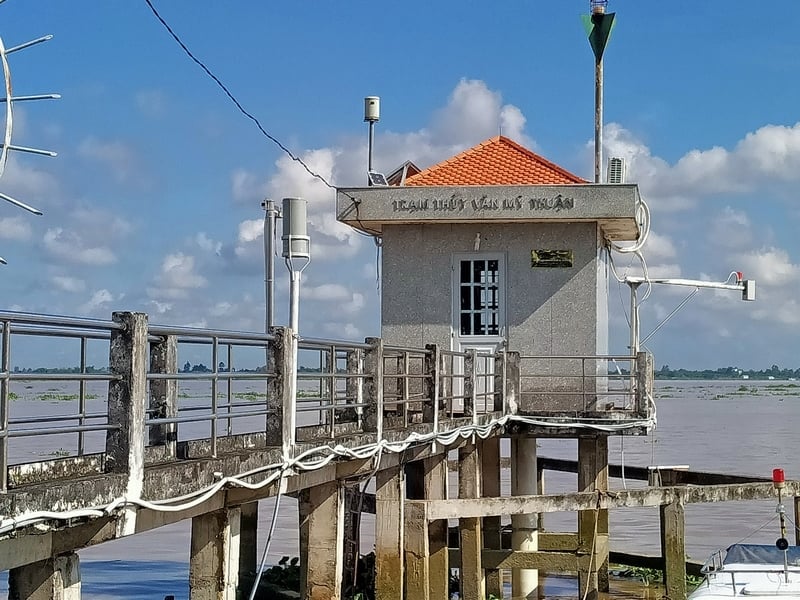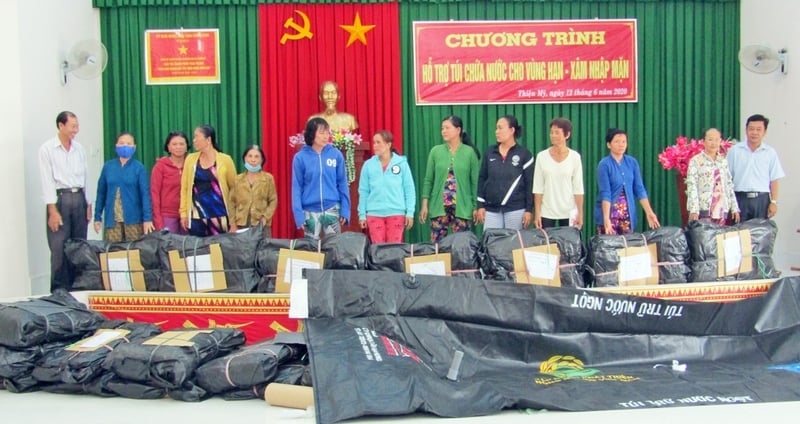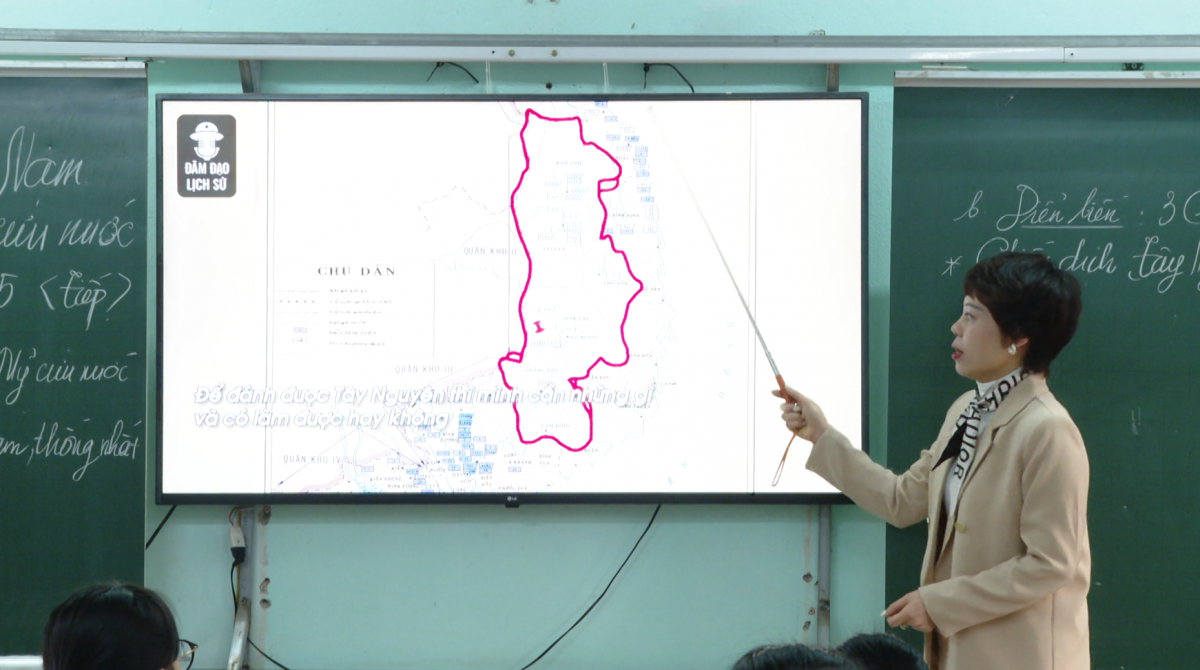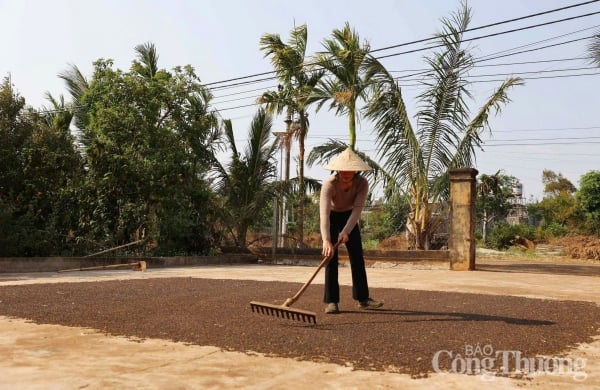 |
| Strengthen monitoring and promptly notify organizations and people to respond to unusually high saline intrusion in the remaining months of the 2024-2025 dry season. In photo: My Thuan hydrological station. |
According to forecasts by domestic professional agencies, saline intrusion (SIP) in the dry season this year (2024-2025) in the Mekong Delta (including Vinh Long province) will not be as severe as in the two dry seasons of 2015-2016 and 2019-2020. However, developments in water resources and SIP since the beginning of the dry season have been unusual compared to the same period in previous years; organizations and people need to continue implementing prevention and control solutions to avoid risks and damage to production and people's lives.
Saltwater intrusion comes 1.5 months earlier
According to the Southern Institute of Water Resources Research, salinity in the Mekong Delta has appeared at a high level during the high tide period from December 24-30, 2024, about 1.5 months earlier than the average of many years (TBNN) and has increased dramatically on the Mekong River mouths compared to the same period in 2015 and 2023.
In Vinh Long, according to the Department of Agriculture and Rural Development of Vung Liem district, from December 27 to 31, 2024, salinity appeared on the Co Chien River in the district. On December 27, the salinity measured at Nang Am sluice (Trung Thanh Dong commune) was 2.7‰, at Mang Thit estuary (Quoi An commune) was 2.6‰; the salinity reached its highest level on December 28 and 29: at Nang Am sluice, Vung Liem estuary was 4.5‰ and at Mang Thit estuary was 2.7‰.
Next, during the high tide during the recent Lunar New Year (from January 27 to February 1, 2025), the salinity in the coastal areas of the Mekong Delta continued to rise to a high level, with the salinity boundary of 4‰ at the Mekong River mouths 42-60km from the sea.
According to the monitoring results of the Provincial Hydrometeorological Station, the highest salinity appeared on January 28 at approximately the same level and higher than the same period in 2024 from 0.1-2.1‰. Specifically, on the Co Chien River, the salinity at Binh Thuy estuary (Thanh Binh commune, Vung Liem district, 42km from the estuary) was measured at 6.1‰; at Nang Am sluice (50km from the estuary) was 5.8‰; at Mang Thit estuary (60km from the estuary) was 4.5‰. On the Hau River, the salinity at Tich Thien commune (Tra On district, 55km from the estuary) was 0.9‰; at Tra On estuary (Tra On town, 65km from the estuary) was 0.3‰.
Also according to the Southern Institute of Water Resources, during the week from February 7-13, 2025, water discharge from Jinghong Hydropower Plant (China) to the downstream fluctuated between 632-642 m3/s, the lowest water discharge week since the beginning of the dry season this year.
Reservoirs in the Mekong River Basin in China have a regulated capacity of 19.76 billion m3, equivalent to 83.1% of the total usable capacity. Reservoirs in the lower Mekong River Basin have 67.8% of the total usable capacity. The total water capacity that can be regulated in the dry season of 2024-2025 in the Mekong River Basin is currently about 48.02 billion m3.
In the Mekong Delta, the salinity boundary of 4‰ is at its deepest point, 37-48km from the sea on the Mekong River branches. In Vinh Long, from February 7-15, the highest salinity appeared on February 11 at Binh Thuy estuary at 3.2‰, at Nang Am sluice at 3.2‰, at Mang Thit estuary at 0.4‰, and at Tich Thien commune at 0.4‰.
Preventing unusual saltwater intrusion
According to the Ministry of Natural Resources and Environment, the annual level of salinity in the Mekong Delta depends mainly on the upstream flow to the delta; in which the regulation of upstream reservoirs plays an extremely important role in the scope of salinity influence and water resources in the delta.
Particularly for this year's dry season (2024-2025), in the Mekong Delta region, the total water volume forecasted to Tan Chau and Chau Doc stations is from 137-143 billion m3, approximately the annual average and about 5% lower than the dry season of 2023-2024. During the peak months of the 2024-2025 dry season (from January to April 2025), the total flow forecasted to Tan Chau and Chau Doc stations is from 48.9-51 billion m3, 2-6% lower than the annual average but about 7-11% higher than the same period in the dry season of 2023-2024.
The peak salinity is likely to penetrate deep into the river mouths in the Mekong River basin during high tides from February to April 2025 with the 4‰ salinity boundary intruding deep into the main river mouths such as: Tien River about 35-50km (about 10-15km lower than in 2024), Hau River about 42-50km (about 7-12km lower than in 2024), Ham Luong River about 45-60km (about 5-10km lower than in 2024), Co Chien River about 40-50km (about 5-10km lower than in 2024) and Cai Lon River about 40-50km (about 5-10km lower than in 2024).
In general, the water resources to the Mekong Delta will basically meet the needs for daily life, social security, economy and environmental protection. However, there is still a risk of local water shortages, mainly due to the fact that the XNM and the irrigation system and the centralized water supply system have not been completed synchronously. Therefore, there is still a potential risk of water shortages if not exploited, used reasonably, economically and effectively.
Also according to the Southern Institute of Water Resources, the lowest water discharge from February 7-13, 2025 from the Jinghong Hydropower Plant mentioned above will affect the coastal areas of the Mekong Delta right at the high tide in early February of the next lunar month; it is forecasted that the salinity may reach its highest peak from the beginning of the dry season from February 28 to March 4, 2025, the 4‰ salinity boundary will have the deepest impact on river mouths about 45-62km.
 |
| Local authorities support people in drought-affected areas with fresh water storage containers. Photo: Archive |
In Vinh Long, according to the forecast of the Provincial Hydrometeorological Station, salinity in the province from now until the end of March 2025 will continue to remain at a high level. In particular, the highest salinity in February on the Co Chien River in Vung Liem District is from 3-5‰, on the Hau River in Tra On District is from 0.3-1.3‰; the highest salinity in March on the Co Chien River in Vung Liem District is from 4.5-7‰ and on the Hau River in Tra On District is from 1-4.5‰.
The situation of drought and water shortage is still unpredictable, so agencies, departments, branches and people in the Mekong Delta region (including Vinh Long province) need to pay attention to the forecast bulletins and continue to implement plans and measures to prevent, combat and respond promptly to drought, water shortage and drought to ensure safety for production and people's lives.
Article and photos: TRUNG CHANH
Source: https://baovinhlong.vn/tin-moi/202502/de-phong-xam-nhap-man-gia-tang-bat-thuong-e4b072a/
































Comment (0)